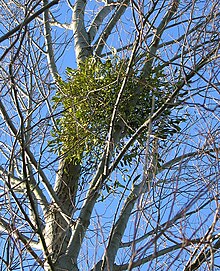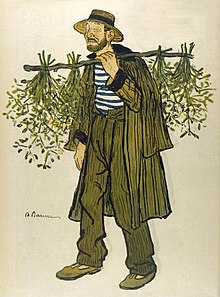
The Santalales are an order of flowering plants with a cosmopolitan distribution, but heavily concentrated in tropical and subtropical regions. It derives its name from its type genus Santalum (sandalwood). Mistletoe is the common name for a number of parasitic plants within the order.

Viscaceae is a taxonomic family name of flowering plants. In this circumscription, the family includes the several genera of mistletoes. This family name is currently being studied and under review as in past decades, several systems of plant taxonomy recognized this family, notably the 1981 Cronquist system.
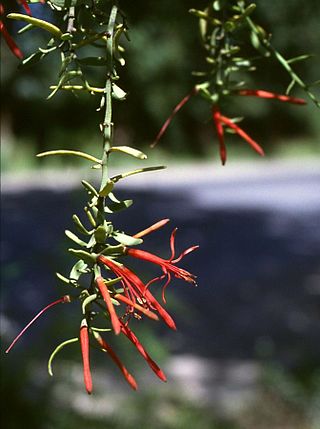
Loranthaceae, commonly known as the showy mistletoes, is a family of flowering plants. It consists of about 75 genera and 1,000 species of woody plants, many of them hemiparasites. The three terrestrial species are Nuytsia floribunda, Atkinsonia ligustrina, and Gaiadendron punctatum Loranthaceae are primarily xylem parasites, but their haustoria may sometimes tap the phloem, while Tristerix aphyllus is almost holoparasitic. For a more complete description of the Australian Loranthaceae, see Flora of Australia online., for the Malesian Loranthaceae see Flora of Malesia.
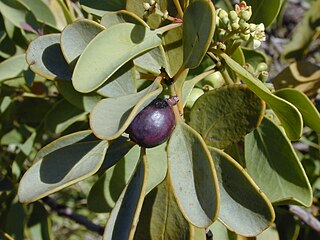
The Santalaceae, sandalwoods, are a widely distributed family of flowering plants which, like other members of Santalales, are partially parasitic on other plants. Its flowers are bisexual or, by abortion, unisexual. Modern treatments of the Santalaceae include the family Viscaceae (mistletoes), previously considered distinct.

The genus Arceuthobium, commonly called dwarf mistletoes, is a genus of 26 species of parasitic plants that parasitize members of Pinaceae and Cupressaceae in North America, Central America, Asia, Europe, and Africa. Of the 42 species that have been recognized, 39 and 21 of these are endemic to North America and the United States, respectively. They all have very reduced shoots and leaves with the bulk of the plant living under the host's bark. Recently the number of species within the genus has been reduced to 26 as a result of more detailed genetic analysis.

Viscum album is a species of mistletoe in the family Santalaceae, commonly known as European mistletoe, common mistletoe or simply as mistletoe. It is native to Europe and western and southern Asia.

Viscum is a genus of about 70–100 species of mistletoes, native to temperate and tropical regions of Europe, Africa, Asia and Australasia. Traditionally, the genus has been placed in its own family Viscaceae, but recent genetic research by the Angiosperm Phylogeny Group shows this family to be correctly placed within a larger circumscription of the sandalwood family, Santalaceae. Its name is the origin of the English word viscous, after the Latin viscum, a sticky bird lime made from the plants' berries.

Phoradendron is a genus of mistletoe, native to warm temperate and tropical regions of the Americas. The center of diversity is the Amazon rainforest. Phoradendron is the largest genus of mistletoe in the Americas, and possibly the largest genus of mistletoes in the world. Traditionally, the genus has been placed in the family Viscaceae, but recent genetic research acknowledged by the Angiosperm Phylogeny Group shows this family to be correctly placed within a larger circumscription of the sandalwood family, Santalaceae.

A parasitic plant is a plant that derives some or all of its nutritional requirements from another living plant. They make up about 1% of angiosperms and are found in almost every biome. All parasitic plants develop a specialized organ called the haustorium, which penetrates the host plant, connecting them to the host vasculature – either the xylem, phloem, or both. For example, plants like Striga or Rhinanthus connect only to the xylem, via xylem bridges (xylem-feeding). Alternately, plants like Cuscuta and some members of Orobanche connect to both the xylem and phloem of the host. This provides them with the ability to extract resources from the host. These resources can include water, nitrogen, carbon and/or sugars. Parasitic plants are classified depending on the location where the parasitic plant latches onto the host, the amount of nutrients it requires, and their photosynthetic capability. Some parasitic plants can locate their host plants by detecting volatile chemicals in the air or soil given off by host shoots or roots, respectively. About 4,500 species of parasitic plants in approximately 20 families of flowering plants are known.

Phoradendron leucarpum is a species of mistletoe in the Viscaceae family which is native to the United States and Mexico. Its common names include American mistletoe, eastern mistletoe, hairy mistletoe and oak mistletoe. It is native to Mexico and the continental United States. It is hemiparasitic, living in the branches of trees. The berries are white and 3–6 millimeters (0.12–0.24 in). It has opposite leaves that are leathery and thick. Ingesting the berries can cause "stomach and intestinal irritation with diarrhea, lowered blood pressure, and slow pulse". This shrub can grow to 1 meter (3.3 ft) by 1 meter (3.3 ft).

Phoradendron californicum, the desert mistletoe or mesquite mistletoe, is a hemiparasitic plant native to southern California, Nevada, Arizona, Sonora, Sinaloa and Baja California. It can be found in the Mojave and Sonoran Deserts at elevations of up to 1400 m.

Phoradendron juniperinum is a species of flowering plant in the sandalwood family known by the common name juniper mistletoe. It is native to the southwestern United States and northern Mexico, where it grows in various types of woodland habitat. It has been reported from California, Nevada, Arizona, New Mexico, Oregon, Utah, Texas, Chihuahua and Sonora.
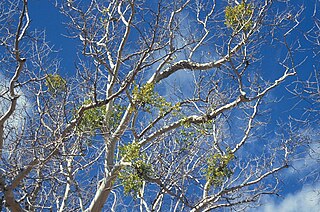
Phoradendron macrophyllum is a species of flowering plant in the sandalwood family known by the common names Colorado Desert mistletoe, bigleaf mistletoe, and Christmas mistletoe. It is native to western United States and northern Mexico from Oregon to Colorado to Texas to Baja California, where it grows in many types of wooded habitat at elevations up to 1700 m.

Dendrophthoe falcata is one of the hemiparasitic plants that belong to the mistletoe family Loranthaceae. It is the most common of all the mistletoes that occur in India. At the moment reports say that it has around 401 plant hosts. The genus Dendrophthoe comprises about 31 species spread across tropical Africa, Asia, and Australia among which 7 species are found in India.

Osyris compressa is a facultatively hemiparasitic, mainly South African plant of the sandalwood family, Santalaceae. Until recently, the favoured binomial name was Colpoon compressum, but around 2001, the genus Colpoon was included in Osyris on the basis of comparative DNA studies. That assignment is not final, however, and according to the Kew Gardens plant list, Colpoon compressum P.J.Bergius, though still in review, is the accepted name.

Phoradendron tomentosum, the leafy mistletoe, hairy mistletoe or Christmas mistletoe, is a plant parasite. It is characterized by its larger leaves and smaller berries than dwarf mistletoe. Leafy mistletoe seldom kill but they do rob their hosts of moisture and some minerals, causing stress during drought and reducing crop productions on fruit and nut trees. Leafy mistletoe has the ability to photosynthesize on its own but it relies on other plants in order to obtain its nutrients. It attaches itself to a tree and then grows haustoria, in order to get the food and water it needs.

Lysiana exocarpi, commonly known as harlequin mistletoe, is a species of hemiparasitic shrub, endemic to Australia. It is in the Gondwanan family Loranthaceae and is probably the most derived genus of that family with 12 pairs of chromosomes. The Loranthaceae is the most diverse family in the mistletoe group with over 900 species worldwide and including the best known species in Australia. Mistletoes are notable for their relationships with other species. In an early reference to the group in Australia Allan Cunningham explorer and first Director of the Royal Botanic Gardens, Sydney, wrote in 1817: "The Bastard Box is frequently much encumbered with the twining adhering Loranthus aurantiacus which 'Scorning the soil, aloft she springs, Shakes her red plumes and claps her golden wings'."

Viscum minimum is a species of mistletoe in the family Santalaceae. It is a parasitic plant native to South Africa.

Daniel Lee Nickrent is an American botanist, working in plant evolutionary biology, including the subdisciplines of genomics, phylogenetics, systematics, population genetics, and taxonomy. A major focus has been parasitic flowering plants, particularly of the sandalwood order (Santalales). His interest in photographic documentation and photographic databases has led to several photographic databases including Parasitic Plant Connection, Phytoimages, Plant Checklist for the Rocky Mountain National Park, and Plant Checklist for the Crab Orchard National Wildlife Refuge.

Amyema miraculosa, also known as the fleshy mistletoe and the round-leaf mistletoe, is an Australian native mistletoe found in all states except Tasmania. It is a woody, hemiparasitic plant, in the Loranthaceae family. Being hemiparasitic, it draws water and minerals from its host, however it photosynthesises to manufacture its own supply of carbohydrates.
